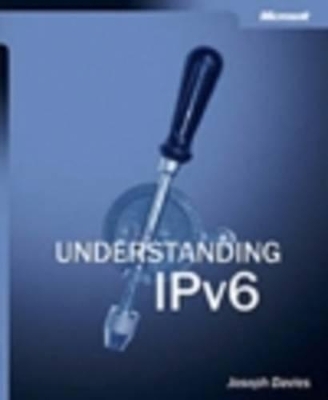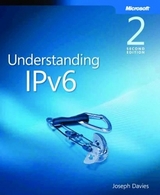
Understanding IPv6
Microsoft Press,U.S.
978-0-7356-1245-7 (ISBN)
- Titel erscheint in neuer Auflage
- Artikel merken
Topics covered include:
Features and benefits of IPv6
IPv6 in the Windows Server 2003 family
IPv6 addressing and the IPv6 header
Internet Control Message Protocol for IPv6 (ICMPv6)
Neighbor and multicast listener discovery
Address autoconfiguration
IPv6 name resolution and routing
Coexistence and migration
IPv6 mobility
Appendixes:
Link layer support for IPv6
Changes to Windows Sockets in IPv6
An IPv6 RFC index
Answers to self-test questions about IPv6
Reference tables
Plus how to set up an IPv6 test lab
To learn of IPv6 developments that have occurred since publication of this book download Updates to Understanding IPv6, a white paper by author Joseph Davies.
Winner of a Distinguished Award and the Best of Show at the Puget Sound Chapter of the Society for Technical Communication (STC), January 2004). Winner of a Distinguished Award at the International STC competition, May 2004.
For customers who purchase an ebook version of this title, instructions for downloading the CD files can be found in the ebook.
Joseph Davies is an award-winning author and instructor with 18 years' experience in TCP/IP, networking, and security technologies. His books include Understanding IPV6, Second Edition and Windows Server 2008 TCP/IP Protocols and Services, and he writes the monthly column "The Cable Guy" for Microsoft TechNet.
List of Figures xix List of Tables xxv Preface xxvii Acknowledgments xxix Introduction xxxi CHAPTERS 1 Introduction to IPv6 1 Limitations of IPv4 1 Consequences of the Limited IPv4 Address Space 3 Features of IPv6 7 New Header Format 7 Large Address Space 7 Efficient and Hierarchical Addressing and Routing Infrastructure 8 Stateless and Stateful Address Configuration 8 Built-in Security 8 Better Support for QoS 9 New Protocol for Neighboring Node Interaction 9 Extensibility 9 Comparison of IPv4 and IPv6 9 IPv6 Terminology 11 The Case for IPv6 Deployment 14 IPv6 Solves the Address Depletion Problem 14 IPv6 Solves the International Address Allocation Problem 14 IPv6 Restores End-to-End Communication 15 IPv6 Uses Scoped Addresses and Address Selection 15 IPv6 has More Efficient Forwarding 16 IPv6 has Built-in Security and Mobility 16 Testing for Understanding 16 2 IPv6 Protocol for the Windows .NET Server 2003 Family 17 Architecture of the IPv6 Protocol for the Windows .NET Server 2003 Family 17 Features of the IPv6 Protocol for the Windows .NET Server 2003 Family 19 Basic Stack Support 19 6to4 20 ISATAP 20 6over4 20 PortProxy 20 Temporary Addresses 20 DNS Support 21 IPSec Support 21 Static Router Support 22 Address Selection 22 Site Prefixes in Router Advertisements 23 Application Support 23 Internet Explorer 23 Telnet Client 24 FTP Client 24 Web Server 24 File and Print Sharing 25 Windows Media Services 25 Network Monitor 25 SNMP MIB Support 25 Application Programming Interfaces 26 Windows Sockets 26 Remote Procedure Call 27 IP Helper 27 Win32 Internet Extensions 27 .NET Framework 28 Installing and Configuring the IPv6 Protocol 28 IPv6-enabled Utilities 28 Ipconfig 29 Route 29 Ping 31 Tracert 33 Pathping 34 Netstat 35 IPv6 Command Line Utilities 38 Netsh.exe 39 Ipsec6.exe 43 Testing for Understanding 43 3 IPv6 Addressing 45 The IPv6 Address Space 45 Current Allocation 46 IPv6 Address Syntax 48 Compressing Zeros 49 IPv6 Prefixes 50 Types of IPv6 Addresses 51 Unicast IPv6 Addresses 52 Aggregatable Global Unicast Addresses 52 Topologies Within Global Addresses 54 Local-Use Unicast Addresses 54 Special IPv6 Addresses 56 Compatibility Addresses 57 NSAP Addresses 57 Multicast IPv6 Addresses 58 Recommended Multicast IPv6 Addresses 60 Solicited-Node Address 60 Anycast IPv6 Addresses 61 Subnet-Router Anycast Address 62 IPv6 Addresses for a Host 62 IPv6 Addresses for a Router 62 Subnetting the IPv6 Address Space 63 Subnetting for NLA IDs 64 Subnetting for SLA IDs/Subnet IDs 69 IPv6 Interface Identifiers 73 EUI-64 Address-based Interface Identifiers 74 Temporary Address Interface Identifiers 78 Mapping IPv6 Multicast Addresses to Ethernet Addresses 79 IPv4 Addresses and IPv6 Equivalents 80 References 81 Testing for Understanding 81 4 The IPv6 Header 85 Structure of an IPv6 Packet 85 IPv4 Header 86 IPv6 Header 89 Values of the Next Header Field 92 Comparing the IPv4 and IPv6 Headers 93 IPv6 Extension Headers 96 Extension Headers Order 97 Hop-by-Hop Options Header 97 Destination Options Header 102 Routing Header 110 Fragment Header 112 Authentication Header 117 Encapsulating Security Payload Header and Trailer 118 IPv6 MTU 118 Upper-Layer Checksums 119 References 120 Testing for Understanding 120 5 ICMPv6 123 Overview of ICMPv6 123 Types of ICMPv6 Messages 124 ICMPv6 Header 124 ICMPv6 Error Messages 125 Destination Unreachable 126 Packet Too Big 128 Time Exceeded 129 Parameter Problem 129 ICMPv6 Informational Messages 131 Echo Request 131 Echo Reply 132 Comparing ICMPv4 and ICMPv6 Messages 133 Path MTU Discovery 135 Changes in PMTU 136 References 137 Testing for Understanding 137 6 Neighbor Discovery 139 Neighbor Discovery Overview 139 Neighbor Discovery Message Format 141 Neighbor Discovery Options 142 Source and Target Link-Layer Address Options 143 Prefix Information Option 144 Redirected Header Option 148 MTU Option 149 Advertisement Interval Option 152 Home Agent Information Option 152 Route Information Option 153 Neighbor Discovery Messages 156 Router Solicitation 156 Router Advertisement 158 Neighbor Solicitation 162 Neighbor Advertisement 165 Redirect 168 Summary of Neighbor Discovery Messages and Options 171 Neighbor Discovery Processes 172 Conceptual Host Data Structures 173 Address Resolution 174 Neighbor Unreachability Detection 178 Duplicate Address Detection 182 Router Discovery 186 Redirect Function 191 Host Sending Algorithm 195 IPv4 Neighbor Messages and Functions and IPv6 Equivalents 197 References 197 Testing for Understanding 198 7 Multicast Listener Discovery 201 Overview of Multicast Listener Discovery 201 IPv6 Multicast Overview 202 Host Support for Multicast 202 Router Support for Multicast 204 MLD Packet Structure 207 MLD Messages 208 Multicast Listener Query 208 Multicast Listener Report 210 Multicast Listener Done 212 Summary of MLD 214 References 214 Testing for Understanding 214 8 Address Autoconfiguration 217 Address Autoconfiguration Overview 217 Autoconfigured Address States 218 Types of Autoconfiguration 219 Autoconfiguration Process 220 IPv6 Protocol for the Windows .NET Server 2003 Family and Windows XP Autoconfiguration Specifics 221 Autoconfigured Addresses for the IPv6 Protocol for the Windows .NET Server 2003 Family and Windows XP 224 References 227 Testing for Understanding 228 9 IPv6 and Name Resolution 229 Name Resolution for IPv6 229 DNS Enhancements for IPv6 229 Name Resolution Support in the Windows .NET Server 2003 Family 231 Hosts File 231 DNS Server Service 232 DNS Resolver 232 DNS Dynamic Update 232 Address Selection Rules 233 References 234 Testing for Understanding 234 10 IPv6 Routing 235 Routing in IPv6 235 IPv6 Routing Table 235 End-to-End IPv6 Delivery Process 239 IPv6 on the Sending Host 239 IPv6 on the Router 240 IPv6 on the Destination Host 243 IPv6 Routing Protocols 246 Overview of Dynamic Routing 246 Routing Protocol Technologies 248 Routing Protocols for IPv6 249 Static Routing with the IPv6 Protocol for the Windows .NET Server 2003 Family and Windows XP 253 References 257 Testing for Understanding 258 11 Coexistence and Migration 261 Coexistence and Migration Overview 262 Node Types 262 Compatibility Addresses 263 Coexistence Mechanisms 265 Dual IP Layer 265 IPv6 over IPv4 Tunneling 266 DNS Infrastructure 268 Tunneling Configurations 269 Router-to-Router 269 Host-to-Router and Router-to-Host 270 Host-to-Host 271 Types of Tunnels 272 6over4 274 6to4 277 6to4 Support in Windows XP and the Windows .NET Server 2003 Family 280 ISATAP 283 Using an ISATAP Router 285 Configuring the IPv6 Protocol for Windows XP and the Windows .NET Server 2003 Family as an ISATAP Router 291 ISATAP and 6to4 Example 292 PortProxy 296 Migrating to IPv6 299 References 299 Testing for Understanding 299 12 IPv6 Mobility 303 IPv6 Mobility Overview 303 IPv6 Mobility Components 304 IPv6 Mobility Messages and Options 307 Destination Options Header Options 307 ICMPv6 Messages 310 Modifications to Neighbor Discovery Messages and Options 312 IPv6 Mobility Data Structures 313 Binding Cache 314 Binding Update List 315 Home Agents List 316 IPv6 Mobility Communication 316 Communication Between a Mobile Node and a Correspondent Node 317 Communication Between a Mobile Node and Its Home Agent 325 IPv6 Mobility Processes 331 Attaching to the Home Link 331 Moving From the Home Link to a Foreign Link 332 Moving from a Foreign Link to Another Foreign Link 341 Returning Home 344 IPv6 Mobility Host Sending Algorithm 347 IPv6 Mobility Host Receiving Algorithm 349 References 352 Testing for Understanding 352 APPENDIXES A Link-Layer Support for IPv6 355 Basic Structure of IPv6 Packets 355 LAN Media 356 Ethernet: Ethernet II 356 Ethernet: IEEE 802.3 SNAP 358 Token Ring: IEEE 802.5 SNAP 360 FDDI 362 WAN Media 364 PPP 365 X.25 367 Frame Relay 369 ATM: Null Encapsulation 370 ATM: SNAP Encapsulation 372 IPv6 over IPv4 373 References 374 B Windows Sockets Changes for IPv6 375 Added Constants 375 Address Data Structures 376 in6_addr 376 sockaddr_in6 376 sockaddr_storage 377 Wildcard Addresses 377 in6addr_loopback and IN6ADDR_LOOPBACK_INIT 378 Core Sockets Functions 378 Name-to-Address Translation 378 Address-to-Name Translation 381 Using getaddrinfo 382 Address Conversion Functions 383 Socket Options 383 New Macros 384 Unsupported APIs 385 References 385 C IPv6 RFC Index 387 General 387 Addressing 387 Applications 388 Sockets API 389 Transport Layer 389 Network Layer 389 Network Layer Security 391 Link Layer 391 Routing 392 Coexistence and Migration 393 D Testing for Understanding Answers 395 Chapter 1: Introduction to IPv6 395 Chapter 2: IPv6 Protocol for the Windows .NET Server 2003 Family 396 Chapter 3: IPv6 Addressing 398 Chapter 4: The IPv6 Header 402 Chapter 5: ICMPv6 403 Chapter 6: Neighbor Discovery 404 Chapter 7: Multicast Listener Discovery 408 Chapter 8: Address Autoconfiguration 409 Chapter 9: IPv6 and Name Resolution 410 Chapter 10: IPv6 Routing 411 Chapter 11: Coexistence and Migration 413 Chapter 12: IPv6 Mobility 415 E Setting Up an IPv6 Test Lab 419 Setting Up the Infrastructure 419 DNS1 421 CLIENT1 421 ROUTER1 422 ROUTER2 422 CLIENT2 423 / IPv6 Test Lab Tasks 424 Link-Local Ping 424 Creating an IPv6 Static Routing Infrastructure 425 Using Name Resolution 427 Using IPSec 428 Using Temporary Addresses 433 F IPv6 Reference Tables 435 GLOSSARY 441 INDEX
| Erscheint lt. Verlag | 13.11.2002 |
|---|---|
| Verlagsort | Redmond |
| Sprache | englisch |
| Maße | 187 x 229 mm |
| Themenwelt | Informatik ► Netzwerke ► TCP / IP und IPv6 |
| Mathematik / Informatik ► Informatik ► Web / Internet | |
| ISBN-10 | 0-7356-1245-5 / 0735612455 |
| ISBN-13 | 978-0-7356-1245-7 / 9780735612457 |
| Zustand | Neuware |
| Informationen gemäß Produktsicherheitsverordnung (GPSR) | |
| Haben Sie eine Frage zum Produkt? |
